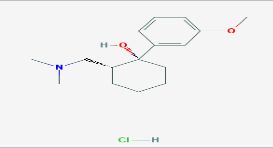Tramadol Hydrochloride Is A Synthetic Codeine Analogue. Tramadol Is A Centrally-acting Synthetic Analgesic Of The Aminocyclohexanol Group With Opioid-like Effects. It Is Not Derived From Natural Sources Nor Is It Chemically Related To Opiates. Tramadol Hydrochloride Has Central Analgesic Properties With Effects Similar To Opioids, Such As Morphine And Codeine Acting On Specific Opioid Receptors. It Is Used As A Narcotic Analgesic For Severe Pain. It Can Be Addictive And Weakly Inhibits Norepinephrine Andserotonin Reuptake. The Opioid-like Activity Of Tramadol Derives From Low Affinity Binding Of Parent Compound To Μ-opioid Receptors And Higher Affinity Binding Of The Principal Active Metabolite, O-desmethyltramadol, Denoted M1, To Μ-opioid Receptors. In Animal Models,m1 Is Up To 6 Times More Potent
Than Tramadol In Producing Analgesia & 200 Times More Potent In Μ-opioid Binding. The Extended-release Form Of Tramadol Is For Around-the-clock Treatment Of Pain. This Form Of Tramadol Is Not For Use On An As-needed Basis For Pain.
Details
Molecular Structure
